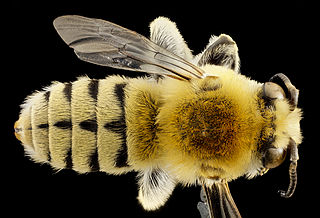Related Research Articles

Carpenter bees are species in the genus Xylocopa of the subfamily Xylocopinae. The genus includes some 500 bees in 31 subgenera. The common name "carpenter bee" derives from their nesting behavior; nearly all species burrow into hard plant material such as dead wood or bamboo. The main exceptions are species in the subgenus Proxylocopa, which dig nesting tunnels in suitable soil.

The genus Halictus is a large assemblage of bee species in the family Halictidae. The genus is divided into 15 subgenera, some of dubious monophyly, containing over 200 species, primarily in the Northern Hemisphere. Most species are black or dark brown, sometimes metallic greenish-tinted, with apical whitish abdominal bands on the terga.

Melitta is a genus of bees in the family Melittidae. It includes about 40 species restricted to Africa and the northern temperate zone. Most of the species are Palaearctic, though three rare species occur in North America.

Thyreus is an Old World genus of bees, one of many that are commonly known as cuckoo bees, or cloak-and-dagger bees, and are kleptoparasites of other species of bees, mostly in the genus Amegilla. They all have strongly contrasting patterns of coloration – three species from the Sydney region, Thyreus nitidulus, T. lugubris, and T. caeruleopunctatus are bright blue and black.

Epeolus is a genus of cuckoo bees in the family Apidae. They are often known as variegated cuckoo-bees.

Habropoda is a genus of anthophorine bees in the family Apidae. There are at least 50 described species in Habropoda.

Pseudoanthidium is a genus of bees belonging to the family Megachilidae. The species of this genus are found in Eurasia, Africa and Australia.
References
- ↑ Shebl, Mohamed (29 December 2016). "Nesting Biology and Seasonality of Long-Horned Bee Eucera nigrilabris Lepeletier (Hymenoptera, Apidae)". Sociobiology. 63 (4): 1031. doi: 10.13102/sociobiology.v63i4.1181 (inactive 2024-05-18).
{{cite journal}}: CS1 maint: DOI inactive as of May 2024 (link) - ↑ Sugiura, Naoto; Maehara, Shoma (December 2019). "Male mate-seeking and mating behaviors of Eucera nipponensis (Hymenoptera: Apidae) at a nectarless orchid habitat: Are empty flower patches a profitable rendezvous site?". Entomological Science. 22 (4): 418–421. doi:10.1111/ens.12388.
- ↑ Shimron, O.; Hefetz, A. (1985). "Mating Behavior and Sex Attraction of Eucera palestinae Friese (Hymenoptera: Anthophoridae)". Journal of the Kansas Entomological Society. 58 (3): 526–531. ISSN 0022-8567. JSTOR 25084672.